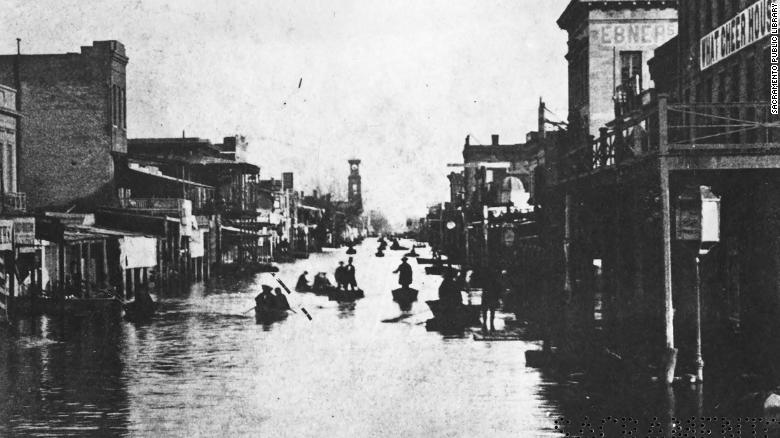From the sky: This is how Kentucky looked after the floods 1:10
(CNN) --
Many Californians fear the "Big One," but it might not be the natural disaster you imagine.
It's not an earthquake.
And it is not the megadrought.
It is actually the exact opposite: a mega-flood.
A new study from Science Advances shows that climate change has already doubled the chances of a disastrous flood in California in the next four decades.
And experts say it would be unlike anything anyone alive has ever experienced.
Daniel Swain, a UCLA climate scientist and researcher who participated in the study, describes a megaflood as "a very severe flooding over a wide region that has the potential to cause catastrophic impacts on society in affected areas."
The scientist says a mega-flood is similar to the 1,000-year flash floods seen this summer in the St. Louis and Kentucky area, but over a much broader area, potentially encompassing the entire state of California.
These massive floods, which experts say would turn California's lowlands into a "vast inland sea," may have occurred before once in a lifetime in the state.
But experts say climate change is increasing the likelihood of these catastrophic disasters, making them happen more like every 25 to 50 years.
Climate change supercharges intense rainfall events, causing flash floods to occur more regularly, as has been seen multiple times this summer in eastern Kentucky, Saint Louis, and even in California's Death Valley National Park. .
advertising
California is naturally prone to these atmospheric river floods, and major floods have already occurred from them, but climate change is upping the ante, and millions of people could be affected.
In just three days, the McKinney fire became the largest in California this year and has already claimed the lives of several people
According to the study, the atmospheric rivers could be consecutive for weeks, as seen in this animation.
Xingying Huang, one of the authors of the study, made this loop, which illustrates the transport of water vapor and the possible accumulation of precipitation in certain time segments during the 30-day scenario.
https://cnnespanol.cnn.com/wp-content/uploads/2022/08/220812115123-mobapp-megaflood-model-water-vapor-animation.mp4
The area with the most destruction would be California's Central Valley, including Sacramento, Fresno and Bakersfield, the study authors project.
The Central Valley, which is about the size of Vermont and Massachusetts combined, produces a quarter of the nation's food supply, according to the US Geological Survey.
According to the study, a flood the size of this valley could be the costliest geophysical catastrophe to date, with an estimated more than $1 trillion in losses and devastating low-lying areas of the state, including Los Angeles and Orange counties. .
This would be five times the cost of Hurricane Katrina, the costliest catastrophe in US history.
"Such a flood in modern California would likely exceed the damage of a major earthquake by a considerable margin," the study says.
In this photo provided by the National Park Service, Mud Canyon Road is closed due to flash flooding in Death Valley, California.
This study is the first phase of a three-part series studying the effects of a future megaflood in California.
The next two phases are expected to be released in two to three years.
"Ultimately, one of our goals is not only to understand these events scientifically, but also to help California prepare for them," Swain said.
"It's a question of when and not if (the mega-flood) happens."
Environmental catastrophes, economic crises and famines.
These are the 5 countries most vulnerable to climate change in Latin America
It has happened before.
It will happen again, but worse, scientists warn
More than 150 years ago, a powerful series of atmospheric rivers flooded the Golden State, causing one of the most exceptional floods in history after a time of drought that had left the West parched for decades.
Communities were demolished in a matter of minutes.
This 1861 photograph shows flooding in Sacramento.
It was the winter of 1861-1862, and a historic mega-flood transformed the San Joaquin and Sacramento valleys into a "temporary but vast inland sea," according to the study.
Some areas had up to 9 meters of water for weeks, destroying infrastructure, farmland and towns.
Sacramento, the new state capital at the time, was under ten feet of debris-filled water for months.
The catastrophe began in December 1861, when almost 4.5 meters of snow fell in the Sierra Nevada.
Repeated atmospheric rivers dropped warm rains for 43 days thereafter, pouring water down mountainsides and into valleys.
Four thousand people lost their lives, a third of the state's property was destroyed, a quarter of California's livestock population drowned or starved, and one in eight homes was a total loss to flood waters.
Additionally, a quarter of the Californian economy was wiped out, bankrupting the entire state.
Swain warns that a mega-flood like this will happen again, but it will be worse and more frequent.
Downtown Sacramento today, which rose 10 to 15 feet after historic flooding.
"We found that climate change has already increased the risk of a mega-flood in California, but that future climate warming will likely cause the risk to increase even more," the study warns.
Many of today's large cities, with millions of people, are built directly on old flood deposits, Swain added, putting many more people at risk.
In 1862, about 500,000 people lived in California.
Now, the state's population exceeds 39 million.
"When this (flood) happens again, the consequences will be very different than in the 1860s," Swain said.
Climate change increases the amount of rain the atmosphere can hold and causes more water to fall into the air as rain, which can cause immediate flooding.
Both things happen and will continue to happen in California.
The new study shows a rapid increase in the probability of strong or extreme week-long atmospheric rivers during the cold season.
An atmospheric river is a long, narrow region of high humidity in the atmosphere that can carry moisture thousands of miles, like a fire hose across the sky.
They often bring beneficial rains to drought-prone regions like California, but could quickly turn dangerous as the climate warms.
California drought could cut state hydropower by half this summer
Historically, these winter atmospheric rivers drop meters of snow on the Sierra Nevada, but as the climate warms, more of the snow will fall as rain.
Instead of slowly melting away over time, it will all drain away, accumulate and flood right away.
California's Central Valley, which produces a quarter of the country's food, will be hit by a mega-flood.
With a neighbor like the Pacific Ocean, California has "an infinite reservoir of water vapor in the sea," Swain added.
California's mountainous terrain and wildfire risk make it especially vulnerable to flooding.
Wildfire burn scars can create a steep, slippery surface for water and debris to flow off of.
As forest fires grow larger and burn more land due to climate change, more areas are susceptible to these debris flows.
Although models show these mega-floods are unavoidable, experts say there are ways to mitigate excessive losses.
"I think the extent of the losses (from mega-floods) can be significantly reduced by doing certain kinds of things to revamp our flood management and our water management systems and our disaster preparedness," Swain said.
Huang, a project scientist at the National Center for Atmospheric Research and a researcher who participated in the study, said everyone can do a little bit to combat climate change.
"If we work together to reduce future emissions, we can also reduce the risk of extreme events," Huang said.
California floods











/cloudfront-eu-central-1.images.arcpublishing.com/prisa/KMEYMJKESBAZBE4MRBAM4TGHIQ.jpg)


